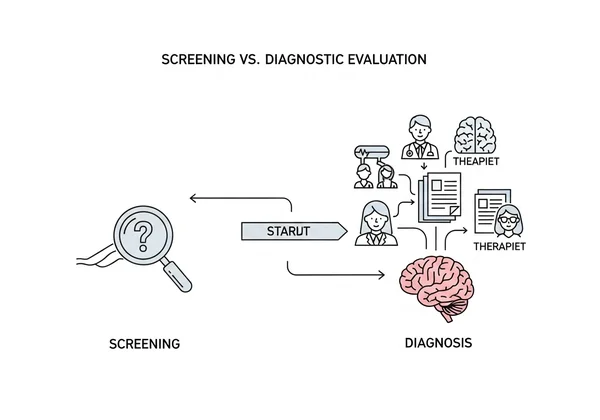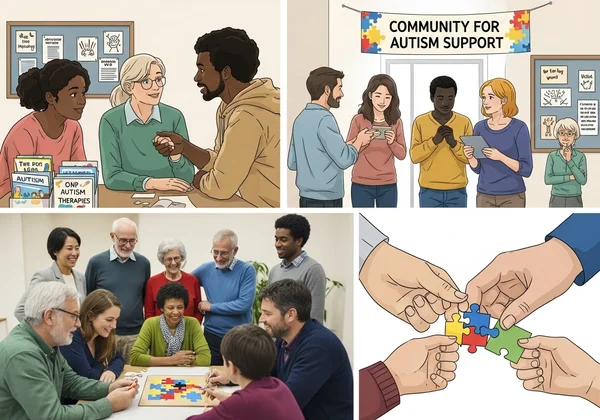Formal Autism Spectrum Test Diagnosis: Steps, Resources & What to Expect
Taking the first steps towards understanding autism, whether for yourself or a loved one, often begins with questions and online research. You might be wondering, How do I know if I am autistic? This curiosity can lead you to valuable initial tools, like an online screening, which can provide preliminary insights. This article serves as your comprehensive guide through the official process of obtaining a professional, formal autism diagnosis, detailing the necessary steps, available resources, and what you can expect on this important journey of discovery. Many begin this path with an autism spectrum test online.
The path to clarity starts with understanding your traits, and a great first step is to get early insights with a science-based screening. While this can illuminate potential areas for further exploration, a formal assessment is the definitive next stage. Let's navigate this process together, empowering you with the knowledge needed to move forward confidently.

Understanding Formal Autism Diagnosis
Understanding the nuances of a formal autism spectrum test diagnosis is crucial for individuals and families seeking clarity. A formal autism diagnosis is a comprehensive evaluation conducted by a qualified healthcare professional to determine if an individual meets the clinical criteria for Autism Spectrum Disorder (ASD). It goes far beyond a simple questionnaire. This process involves in-depth observation, interviews, and standardized testing to build a complete picture of a person's developmental history, social communication skills, and behavioral patterns. It is the key to unlocking official support and a deeper understanding of oneself.
Why a Formal Assessment Matters
While self-identification is valid and personal, a formal diagnosis provides access to crucial resources and support systems. For children, it can unlock tailored educational plans (like an IEP), specialized therapies (speech, occupational), and government support services. For adults, a diagnosis can lead to workplace accommodations, access to mental health services that understand neurodiversity, and a framework for self-understanding that can be life-changing. It validates an individual's experiences and provides a clear path for seeking appropriate support.
Screening vs. Diagnostic Evaluation: What's the Difference?
It is vital to distinguish between a screening and a diagnostic evaluation. An online tool, such as a free autism spectrum test, is a screening measure. It is designed to identify potential signs or traits associated with autism quickly and conveniently. These screenings are based on established research, like the Autism Spectrum Quotient (AQ) test, and are an excellent, accessible starting point.
However, a screening is not a diagnosis. A positive screening result indicates that a full diagnostic evaluation is recommended. This formal assessment is a much more thorough and personalized process conducted by a professional, leading to a clinical conclusion. Think of an online screening as a signpost, pointing you in the right direction for a more detailed exploration.

Steps to Getting an Autism Assessment
The journey to an autism assessment can seem daunting, but it can be broken down into manageable steps. The process is designed to be thorough to ensure an accurate and helpful outcome for the individual. It requires patience and advocacy, whether you are seeking it for yourself or a child.
Initial Consultations and Referrals
The first step is typically to speak with a trusted healthcare provider. For a child, this is usually their pediatrician or a family doctor. For an adult, it would be a general practitioner (GP) or a primary care physician. During this consultation, you should share your observations, concerns, and the results of any online autism screening you may have completed. Based on this conversation, the doctor can provide a referral to a specialist for a comprehensive evaluation.
Who Conducts a Comprehensive Evaluation?
A formal autism diagnosis is conducted by professionals with specific training in neurodevelopmental disorders. These specialists may include:
- Developmental Pediatricians: Doctors who specialize in child development.
- Child or Adult Psychiatrists: Medical doctors specializing in mental health.
- Clinical Psychologists or Neuropsychologists: Experts in brain function, behavior, and mental health who are trained in diagnostic testing.
- Neurologists: Doctors who specialize in disorders of the brain and nervous system.
Finding the right professional is a key part of the ASD diagnosis process. Often, evaluations are performed by a team to ensure a well-rounded perspective.

Key Components of an ASD Evaluation
A comprehensive assessment involves multiple components to gather a complete picture. This may include a detailed medical and developmental history, interviews with the individual and family members, and direct observation of social and communication skills. Professionals often use standardized tools like the Autism Diagnostic Observation Schedule, Second Edition (ADOS-2) and the Autism Diagnostic Interview-Revised (ADI-R). These are considered gold-standard instruments for assessing autism across different ages.
Finding Where to Get a Formal Diagnosis
Knowing where to get a formal diagnosis is one of the biggest hurdles for many individuals and families. Resources can vary significantly based on your location and healthcare system, but there are common avenues to explore.
Locating Qualified Professionals & Centers
Start with the referral from your primary care physician, as they often have a network of trusted specialists. University hospitals or medical centers with developmental or psychiatric departments are excellent resources. You can also contact national or local autism advocacy organizations, as they often maintain lists of diagnostic centers and qualified professionals in your area. An adult autism assessment online screening can be a good document to bring to these professionals.
Navigating Insurance and Financial Considerations
The cost of an evaluation can be a significant concern. The first step is to contact your insurance provider to understand what your plan covers regarding diagnostic assessments for neurodevelopmental disorders. Some diagnostic centers may offer sliding-scale fees based on income, and some non-profit organizations provide grants or financial assistance to help cover the costs. It is important to ask about payment options and potential support when you schedule the appointment.
Navigating the Post-Diagnosis Process
Receiving a diagnosis is not the end of the journey; it is the beginning of a new, more informed chapter. The ASD diagnosis process includes understanding the results and creating a plan for the future. This is where you can truly start to leverage your new insights for positive change.
Understanding Your Diagnosis Report and Recommendations
After the evaluation, you will receive a detailed diagnosis report. This document will explain the findings, confirm the diagnosis, and outline the individual's specific strengths and challenges. It will also include personalized recommendations for therapies, educational support, and other resources. Take time to review this report and ask the diagnosing professional any questions you have.
Next Steps: Support, Therapies, and Community Resources
The report's recommendations are your roadmap. This could involve connecting with speech therapists, occupational therapists, or mental health counselors who specialize in autism. It is also incredibly beneficial to connect with the autism community. Finding support groups, online forums, and local meetups can provide a sense of belonging and invaluable shared experience for both autistic individuals and their families. Exploring resources for a childhood autism spectrum test can also offer further insight.

Your Empowered Path Forward After an Autism Diagnosis
Navigating the path to a formal autism diagnosis is a proactive step toward empowerment and understanding. From the initial questions and online screenings to a comprehensive evaluation and post-diagnosis support, each stage brings you closer to clarity. This journey allows you to access the right tools, accommodations, and community to thrive.
Remember, understanding begins with a single step. If you are just starting to explore this for yourself or a loved one, we encourage you to try our free tool today. Let it be the start of your informed journey toward answers and support.
Frequently Asked Questions About Autism Diagnosis
How to get a formal autism diagnosis?
To get a formal autism diagnosis, you should first consult with a primary healthcare provider, such as a GP or pediatrician. Share your concerns and any preliminary screening results. They can then provide a referral to a qualified specialist, like a psychologist or psychiatrist, who can conduct a comprehensive diagnostic evaluation.
What to do after a positive autism screening test?
After a positive autism screening test, the recommended next step is to seek a formal evaluation from a qualified professional. An online screening, like the autism spectrum test available on our site, is a valuable first step that indicates further assessment is warranted. Share the results of your screening with your doctor to discuss pursuing a full diagnostic assessment.
Is an online autism test accurate?
An online autism test is best viewed as a reliable screening tool, not a diagnostic one. High-quality tests are based on scientifically validated questionnaires and can accurately indicate the presence of autistic traits. However, they cannot replace a formal diagnosis made by a healthcare professional, which involves a much more in-depth and personalized evaluation.
Can you be mildly autistic?
Yes, autism is a spectrum, meaning it affects every individual differently. Some people may have traits that are considered "mild" or may require lower levels of support, which was previously associated with terms like Asperger's syndrome. A formal diagnosis will clarify an individual's specific profile of strengths and support needs, regardless of where they fall on the spectrum.